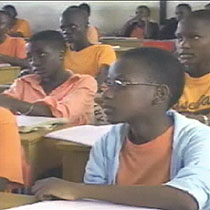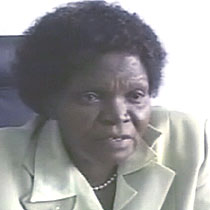2007年VOA标准英语-Ugandan Government Launches Program to Boost Se
时间:2019-02-08 作者:英语课 分类:2007年VOA标准英语(六月)
Kampala, Uganda
12 June 2007
Earlier this year, Uganda launched its Universal Secondary Education program to enable more students from low-income and rural families to get a high school education. Cathy Majtenyi files this report for VOA on the challenges and rewards that lie ahead.

Uganda students
This year, some 155,000 primary school graduates who scored high marks are being admitted to some of Uganda's 790 government-sponsored and 350 private high schools across the country under the Universal Secondary Education program, or USE as it is commonly known.
Until now, less than half of all students who finished primary school made it to secondary school, largely because their families were unable to afford the school fees.
But with the USE program, the Ugandan government is aiming to have at least 60 percent of primary school graduates move on to secondary school this first year

Geraldine Namirembe Bitamazire
Geraldine Namirembe Bitamazire is Uganda's minister of education. She explains why it is important for more students to be given the chance to get a secondary school education. "We are industrializing. We want to start modern economic activities and programs. We are adopting the information and communications technology and sciences. We as a country and a government, we can't see how we can move into those areas without an educated, well literate 1 community."
But providing spaces for so many students at once may prove to be easier said than done. When Uganda implemented 2 its Universal Primary Education program 10 years ago, schools faced serious shortages of teachers, classrooms, learning materials and other equipment as they were being swamped with new students.

The education ministry 3 says it is relying on private schools, parents, donors 5, and innovative 6 strategies to fill in the gaps.
Ms. Bitamazire, adds, "In the over-enrolled schools we are introducing what we call double-shift sessions, a school in the morning up to one (p.m.) and a school in the afternoon up to six (p.m.), because we cannot easily multiply the numbers of schools, but we can use one school for two schools in one day."
Joseph Apira is head teacher at Koro Secondary School in Gulu, northern Uganda. He describes his school's plans to accommodate 200 more students this year. "There are quite a number of changes that we are trying to make. One of them is to work up together with the parents in order to work together with the local community and put in more buildings. Secondly 7, the non-governmental organizations who are in the area, they are helping 8 to accommodate these students too -- constructing some classrooms for them so that the schools can cope up with that number. And the Ministry of Education is also coming up with these payments and their developmental policies."
The government says it is approaching outside donors to provide funds and other assistance for the secondary school program.
Tsuyoshi Okamoto works for the Japan International Cooperation Agency as an advisor 9 to science and math secondary school teachers in Uganda. He says it may be difficult for the government to get this donor 4 support. "We need more international attention on the secondary education. So far, what I observe -- this is my personal opinion -- is that most of the international donors stick with primary education. I understand that this is because of the [United Nations] Millennium 10 Development Goals. They want to achieve these Millennium Development Goals and Uganda is on the right track."
If all goes according to plan, one million more students will be in the secondary school system in four years time. That will mean that 80 percent of children who finish primary school can get a high school education.
For many children from low income and rural families, this will be a dream come true.
- Only a few of the nation's peasants are literate.这个国家的农民中只有少数人能识字。
- A literate person can get knowledge through reading many books.一个受过教育的人可以通过读书而获得知识。
- This agreement, if not implemented, is a mere scrap of paper. 这个协定如不执行只不过是一纸空文。 来自《现代汉英综合大词典》
- The economy is in danger of collapse unless far-reaching reforms are implemented. 如果不实施影响深远的改革,经济就面临崩溃的危险。 来自辞典例句
- They sent a deputation to the ministry to complain.他们派了一个代表团到部里投诉。
- We probed the Air Ministry statements.我们调查了空军部的记录。
- In these cases,the recipient usually takes care of the donor afterwards.在这类情况下,接受捐献者以后通常会照顾捐赠者。
- The Doctor transplanted the donor's heart to Mike's chest cavity.医生将捐赠者的心脏移植进麦克的胸腔。
- Please email us to be removed from our active list of blood donors. 假如你想把自己的名字从献血联系人名单中删去,请给我们发电子邮件。
- About half this amount comes from individual donors and bequests. 这笔钱大约有一半来自个人捐赠及遗赠。 来自《简明英汉词典》
- Discover an innovative way of marketing.发现一个创新的营销方式。
- He was one of the most creative and innovative engineers of his generation.他是他那代人当中最富创造性与革新精神的工程师之一。
- Secondly,use your own head and present your point of view.第二,动脑筋提出自己的见解。
- Secondly it is necessary to define the applied load.其次,需要确定所作用的载荷。
- The poor children regularly pony up for a second helping of my hamburger. 那些可怜的孩子们总是要求我把我的汉堡包再给他们一份。
- By doing this, they may at times be helping to restore competition. 这样一来, 他在某些时候,有助于竞争的加强。
- They employed me as an advisor.他们聘请我当顾问。
- The professor is engaged as a technical advisor.这位教授被聘请为技术顾问。
- The whole world was counting down to the new millennium.全世界都在倒计时迎接新千年的到来。
- We waited as the clock ticked away the last few seconds of the old millennium.我们静候着时钟滴答走过千年的最后几秒钟。